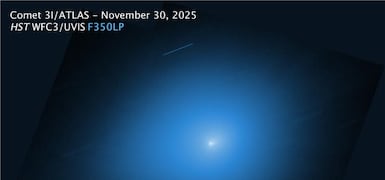
A partial lunar eclipse that coincides with the Moon’s perigee, that is, the closest point of our satellite to Earth, will occur on the night of Tuesday, September 17 and the early morning of Wednesday, September 18 during the supermoon or Full Harvest Moon in The United States and people are preparing for this unique celestial spectacle. According to NASA (National Aeronautics and Space Administration), the astronomical phenomenon will be visible in half of the United States territory with the best experiences in the states of Texas, Florida, New York, Illinois and Michigan.
Why do lunar eclipses occur?
Let’s imagine that the Earth is a large ball and the Moon is a smaller ball that revolves around it. The Sun, in turn, is a huge source of light. A partial lunar eclipse occurs when the Earth comes between the Sun and the Moon, but not completely. That is, the Earth’s shadow (called umbra) covers only part of the Moon.

Will it turn red, like during a “blood moon”? It may look a little reddish, but for 62 minutes, the moon will look very strange. The spectacle of the Earth’s shadow cast sideways on the lunar surface is one of the strangest in astronomy.
What time does the lunar eclipse start in the United States? Phase times
Este es el cronograma del eclipse lunar que se producirá del 17 al 18 de septiembre en los Estados Unidos.
Eastern Daylight Time (EDT)
- Penumbral eclipse begins: 8:41 p.m. EDT on Tuesday, September 17
- Partial eclipse begins: 10:12 p.m. EDT on Tuesday, September 17
- Greatest eclipse: 10:44 p.m. EDT on Tuesday, September 17
- Partial eclipse ends: 11:15 p.m. EDT on Tuesday, September 17
- Penumbral eclipse ends: 00:47 a.m. EDT on Wednesday, September 18
Central Daylight Time (CDT)
- Penumbral eclipse begins: 7:41 p.m. CDT on Tuesday, September 17
- Partial eclipse begins: 9:12 p.m. CDT on Tuesday, September 17
- Greatest eclipse: 9:44 p.m. CDT on Tuesday, September 17
- Partial eclipse ends: 10:15 p.m. CDT on Tuesday, September 17
- Penumbral eclipse ends: 11:47 p.m. CDT on Tuesday, September 17
Mountain Daylight Time (MDT)
- Penumbral eclipse begins (not visible): 6:41 on Tuesday, September 17
The moon will rise around 7:00 p.m. MDT
- Partial eclipse begins: 8:12 p.m. MDT on Tuesday, September 17
- Greatest eclipse: 8:44 on p.m. MDT Tuesday, September 17
- Partial eclipse ends: 9:15 p.m. MDT on Tuesday, September 17
- Penumbral eclipse ends: 10:47 p.m. MDT on Tuesday, September 17
Mountain Standard Time (MST)
- Penumbral eclipse begins (not visible): 5:41 p.m. MST on Tuesday, September 17
The moon will rise around 6:30 p.m. MST
- Partial eclipse begins: 7:12 p.m. MST on Tuesday, September 17
- Greatest eclipse: 7:44 p.m. MST on Tuesday, September 17
- Partial eclipse ends: 8:15 p.m. MST on Tuesday, September 17
- Penumbral eclipse ends: 9:47 p.m. MST on Tuesday, September 17
Pacific Daylight Time (PDT)
- Penumbral eclipse begins (not visible): 5:41 p.m. PDT on Tuesday, September 17
The moon will rise around 6:55 p.m. PDT
- Partial eclipse begins: 7:12 p.m. PDT on Tuesday, September 17
- Greatest eclipse: 7:44 p.m. PDT on Tuesday, September 17
- Partial eclipse ends: 8:15 p.m. PDT on Tuesday, September 17
- Penumbral eclipse ends: 9:47 p.m. PDT on Tuesday, September 17
Lunar eclipse times for September 17 in US states
Based on the state’s time zone (PT, MT, CT, and ET), here’s the full schedule to enjoy the partial lunar eclipse on September 17 and 18 in the United States.
| US States | Beginning of the penumbral lunar eclipse | End of the penumbral lunar eclipse |
|---|---|---|
| Alabama | 19: 41 CDT | 23:47 CDT |
| Alaska | 18:52 AKDT | 20:47 AKDT |
| Arizona | 18:17 MST | 21:47 AKDT |
| Arkansas | 19:41 CDT | 23:47 CDT |
| California | 18:39 MST | 21:47 CDT |
| Colorado | 19:50 CDT | 22:47 MDT |
| Connecticut | 20:41 EDT | 00:47 EDT |
| Delaware | 20:41 EDT | 00:47 EDT |
| District of Columbia | 20:41 EDT | 00:47 EDT |
| Florida | 20:41 EDT | 00:47 EDT |
| Georgia | 20:41 EDT | 00:47 EDT |
| Hawaii | 18:22 HST | 18:47 HST |
| Idaho | 19:29 MDT | 22:47 MDT |
| Illinois | 19:41 CDT | 22:47 MDT |
| Indiana | 20: 41 CDT | 00:47 CDT |
| Iowa | 19:41 EDT | 23:47 EDT |
| Kansas | 19:41 EDT | 23:47 EDT |
| Kentucky | 20: 41 CDT | 00:47 CDT |
| Luisiana | 19:41 CDT | 23:47 CDT |
| Maine | 20: 41 EDT | 00:47 EDT |
| Maryland | 20: 41 EDT | 00:47 EDT |
| Massachusetts | 20: 41 EDT | 00:47 EDT |
| Michigan | 20: 41 EDT | 00:47 EDT |
| Minnesota | 19:41 CDT | 23:47 CDT |
| Misisipi | 19:41 CDT | 23:47 CDT |
| Misuri | 19:41 CDT | 23:47 CDT |
| Montana | 19:02 MDT | 22:47 MDT |
| Nebraska | 19:41 CDT | 23:47 CDT |
| Nevada | 18:39 PDT | 21:47 PDT |
| New Hampshire | 20: 41 EDT | 00:47 EDT |
| New Jersey | 20: 41 EDT | 00:47 EDT |
| New México | 18:53 MDT | 22:47 MDT |
| New York | 20: 41 EDT | 00:47 EDT |
| North Carolina | 20: 41 EDT | 00:47 EDT |
| North Dakota | 19:41 CDT | 23:47 CDT |
| Ohio | 20: 41 EDT | 00:47 EDT |
| Oklahoma | 19:41 CDT | 00:47 EDT |
| Oregón | 19:52 MDT | 21:47 PDT |
| Pennsylvania | 20:41 EDT | 00:47 EDT |
| Rhode Island | 20:41 EDT | 00:47 EDT |
| South Carolina | 20:41 EDT | 00:47 EDT |
| South Dakota | 19:41 CDT | 23:47 CDT |
| Tennessee | 19:41 CDT | 23:47 CDT |
| Texas | 19:41 CDT | 23:47 CDT |
| Utah | 19:19 MDT | 22:47 MDT |
| Vermont | 20:41 EDT | 00:47 EDT |
| Virginia | 20:41 EDT | 00:47 EDT |
| Washington | 18:54 PDT | 21:47 PDT |
| Virginia Occidental | 20:41 EDT | 00:47 EDT |
| Wisconsin | 19:41 CDT | 23:47 CDT |
| Wyoming | 19:00 MDT | 22:47 MDT |
How long does the lunar eclipse last?
All phases of the lunar eclipse will last 4 hours and 6 minutes. The partial eclipse, when the Moon is in the dark shadow of the Earth, will last only 1 hour and 3 minutes. You’ll need special equipment to see it. This eclipse will not harm your vision if you look directly at it.
Where to watch the partial lunar eclipse live and online from the United States?
- Below is a list of specialized sites that will broadcast the partial lunar eclipse from September 17 to 18 in the United States:
- TimeAndDate: The specialized site will offer live coverage of the partial lunar eclipse from its official YouTube channel starting at 9 pm ET (8 pm CT, 7 pm MT and 6 pm PT).

- Virtual Telescope Project: The YouTube channel of Italian astronomer Gianluca Masi will also offer live streaming of the partial lunar eclipse starting at 8:30 pm ET with the help of his powerful telescope.

- Adler Planetarium: The Adler Planetarium in Chicago will also offer a live stream of the partial lunar eclipse between 9 pm or 10 pm ET.
Why does the Moon turn red during the eclipse?
The Moon appears red because light shining on it passes through Earth’s atmosphere, which scatters blue light and directs (or refracts) red light toward the Moon. Sizes and distances are not to scale. The intensity of the red color depends on the Moon’s position in Earth’s shadow. This phenomenon is also known as a “blood moon.”
Which US states will be able to see the lunar eclipse?
The lunar eclipse on September 17-18 will be best seen in almost half of the United States:
Alabama, Alaska, Arizona, Arkansas, California, Colorado, Connecticut, Delaware, District of Columbia, Florida, Georgia, Hawaii, Idaho, Illinois, Indiana, Iowa, Kansas, Kentucky, Louisiana, Maine, Maryland, Massachusetts, Michigan, Minnesota, Mississippi, Missouri, Montana, Nebraska, Nevada, New Hampshire, New Jersey, New Mexico, New York, North Carolina, Ohio, Oklahoma, Oregon, Pennsylvania, Rhode Island, South Carolina, South Dakota, Tennessee, Texas, Utah, Vermont, Virginia, Washington, West Virginia, Wisconsin, and Wyoming.
Which countries will see the partial lunar eclipse on September 17?
Countries in Asia, Africa, North America, South America, Pacific, Atlantic, Indian Ocean, Arctic, and Antarctica.

When is the next lunar eclipse?
The next lunar eclipse will be the total eclipse on March 13-14, 2025. It is also known as the Blood Moon because, during a total lunar eclipse, the lunar disk turns red, creating a beautiful and slightly spooky sight in the sky.
At least part of this event will be visible from Europe, much of Asia, Australia, Africa, all of North America, South America, the Pacific and Atlantic oceans, the Arctic, and Antarctica.
Date of upcoming eclipses
- Partial solar eclipse: October 2, 2024
- Total lunar eclipse: March 13-14, 2025
- Partial solar eclipse: March 29, 2025
- Total lunar eclipse: September 7, 2025




